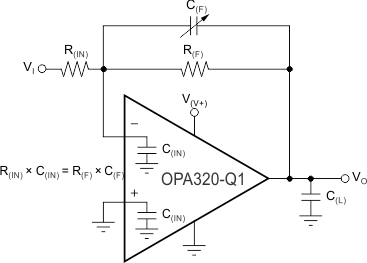SLOS884B September 2014 – December 2018 OPA2320-Q1 , OPA320-Q1
PRODUCTION DATA.
- 1 Features
- 2 Applications
- 3 Description
- 4 Revision History
- 5 Pin Configuration and Functions
- 6 Specifications
- 7 Detailed Description
- 8 Application and Implementation
- 9 Power Supply Recommendations
- 10Layout
- 11Device and Documentation Support
- 12Mechanical, Packaging, and Orderable Information
Package Options
Mechanical Data (Package|Pins)
- DGK|8
Thermal pad, mechanical data (Package|Pins)
Orderable Information
7.3.2 Feedback Capacitor Improves Response
For optimum settling time and stability with high-impedance feedback networks, adding a feedback capacitor across the feedback resistor, R(FB), as shown in Figure 30 may be necessary. This capacitor compensates for the zero created by the feedback network impedance and the OPAx320-Q1 input capacitance (and any parasitic layout capacitance). The effect becomes more significant with higher impedance networks.

NOTE:
Where C(IN) is equal to the OPAx320-Q1 input capacitance (approximately 9 pF) plus any parasitic layout capacitance.It is suggested that a variable capacitor be used for the feedback capacitor because input capacitance may vary between op amps and layout capacitance is difficult to determine. For the circuit shown in Figure 30, the value of the variable feedback capacitor should be chosen so that the input resistance times the input capacitance of the OPAx320-Q1 (9 pF, typical) plus the estimated parasitic layout capacitance equals the feedback capacitor times the feedback resistor:
where
- C(IN) is equal to the OPAx320-Q1 input capacitance (sum of differential and common-mode) plus the layout capacitance.
The capacitor value can be adjusted until optimum performance is obtained.